Welcome to The Azadi Briefing, an RFE/RL newsletter that unpacks the key issues in Afghanistan. To subscribe, click here.
I'm Abubakar Siddique, senior correspondent at RFE/RL's Radio Azadi. Here's what I've been tracking and what I'm keeping an eye on in the days ahead.
The Key Issue
Afghan refugees and migrants have complained of rising harassment and abuse in neighboring Iran.
This week, banners appeared to be hung in a neighborhood in Tehran, the Iranian capital, demanding that Afghans leave. It was unclear if locals or the authorities were behind the move.
It came after Iranian media reported on July 18 that a local man was allegedly stabbed to death by his Afghan neighbors.
Last week, the homes of several Afghan migrants in the southern city of Khur were reportedly set on fire in apparent retaliation for the killing of an Iranian man, allegedly by an Afghan.
Why It's Important: Anti-Afghan sentiment in Iran has been on the rise in recent years, especially after a mass influx of refugees and migrants following the Taliban's takeover of Afghanistan in 2021.
Tehran has long blamed Afghans for insecurity and unemployment in Iran, and expelled many members of the community.
An estimated 4.3 million Afghans currently live in Iran, according to the United Nations. More than 1 million have been deported in the past year.
Human rights groups have also documented a sharp rise in the number of Afghans executed in Iran so far this year.
What's Next: As anti-Afghan sentiment rises in Iran, members of the community are likely to be the targets of more discrimination and abuse.
It is unclear if the ill-treatment of Afghans in Iran will discourage others from moving to the Islamic republic.
Hundreds of Afghans are believed to be illegally entering Iran every week to escape Taliban rule and the devastating humanitarian and economic crises in Afghanistan.
What To Keep An Eye On
A growing number of Afghans affected by natural disasters are leaving for neighboring countries.
Afghanistan has been the scene of severe droughts, floods, and other extreme weather events in recent years.
"I was forced to move to Iran after the earthquakes," Hassanzada, a resident of the western Afghan city of Herat, told RFE/RL's Radio Azadi.
A series of tremors last year killed at least 1,000 people and affected more than 100,000 in and around Herat.
But survivors said the lack of aid and financial assistance forced them to leave the country.
Why It's Important: Afghanistan remains among the world's most vulnerable countries to the effects of global warming and climate change.
In the latest natural disaster to hit Afghanistan, flash floods in the eastern province of Nangarhar last week killed at least 71 people, according to the UN.
The Taliban's seizure of power led international donors to immediately cut international development funding. While some foreign aid organizations continue to operate in Afghanistan, many of them have been forced to curb their work as international funding diminishes.
That's all from me for now.
Don't forget to send me any questions, comments, or tips that you have. You can always reach us at azadi.english@rferl.org
Until next time,
Abubakar Siddique
If you enjoyed this briefing and don't want to miss the next edition, subscribe here. It will be sent to your inbox every Friday.


